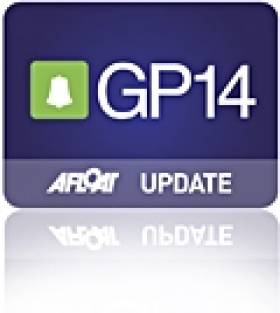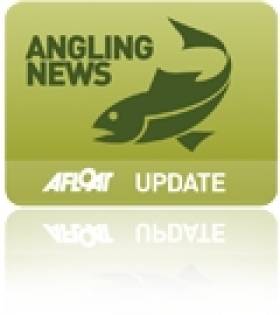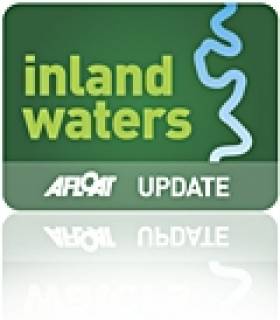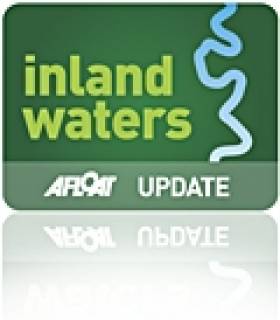Displaying items by tag: Blackwater
Blackwater River Dinghy Cruise Voyages from Youghal to Villierstown
#dinghycruise – As previewed by Afloat.ie, last Saturday four visiting and five local GP14 dinghies crewed by 21 seafarers and two sea dogs set off from Youghal quay in County Cork at low water on the second annual Y2V Blackwater river cruise writes Norman Lee.
Molly the younger sea dog soon got the hang of scrambling to windward on almost every tack but sometimes preferred to stay to leeward to view the wildlife better and she probably set the tone for the many pre teen crews getting a taste for competitive/fun sailing in their respective dads racing machines.
The youngest boat was a beautiful Duffin built this year for Simon Culley and Libby Tierney of Blessington and the oldest, a lovely Bell Woodworking boat nearly 60–years–old and still in perfect fettle, now owned by 16–year–old Jack Nolan of Youghal.
One Mermaid and one Feva came along for the trip which included forming part of the backdrop for a society wedding in Ballintra House a classic yellow mansion, where a band serenaded us as we sailed by on a wide sweep of the river.
Villierstown Boating & Activities Club members at their brand new three week old facility on the riverbank couldn't do enough to make us welcome with hot soup tea and sambos and home cookies when we arrived and a massive fry on Sunday morning and free run of their facilities for the duration.
The value these guys have got from their sports council grant is unbelievable and great credit to all concerned and the welcome the GP visitors get in both Villierstown and Youghal makes it very possible this will be a well attended new addition to the annual GP circuit where the utility design of our boat comes to the fore.
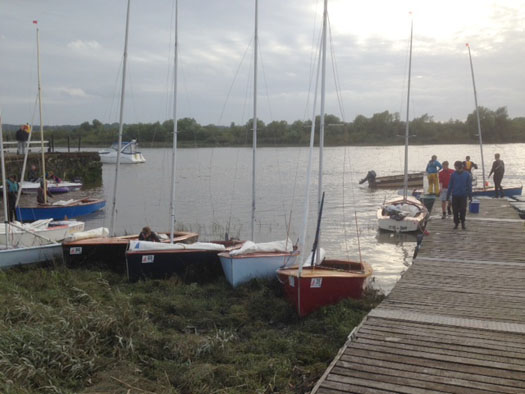
GP14s berth on the river bank
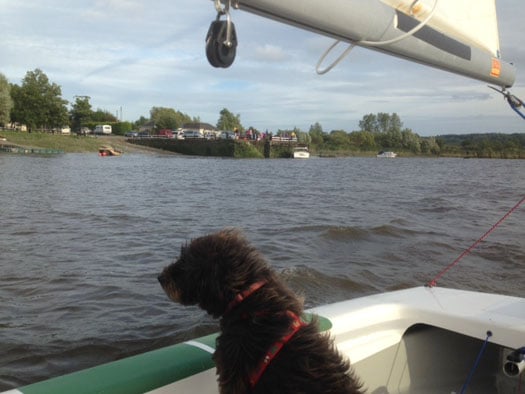
Molly, just one of two seadogs on the cruise keeps a look out
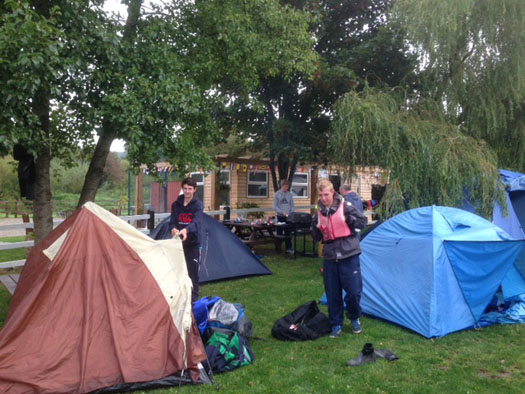
Getting the tents ready at the new Villierstown clubhouse
More on dinghy cruising possibilities here: Is 'Adventure Sailing' a New Tack for Dinghy Sailors?
Sailing in Youghal Boost From Blackwater Voyage to Cappoquin
#youghal – The Munster Blackwater is one of Ireland's mystery rivers writes W M Nixon. Despite comparisons to the Rhine, it keeps much of its long and beautiful length well hidden. And even when it reaches the sea at Youghal, that ancient seaport town manages to be shaped in such a way, with a clutter of waterfront buildings obstructing the view, that it's often impossible to see the water, and whether it's river or sea or both.
As for seeing the boats based there, it's hit or miss. They may be hidden away in muddy little docks, or lying to moorings in the strong tidal stream, or else in the anchorage across the estuary on the east shore at Ferry Point. One way or another, they're well scattered. So anyone voicing the ambition of making Youghal "the Kinsale of East Cork" has a mountain to climb.
But a Youghal schoolboy, Adrian Lee, has come up with a good idea for promoting sailing in Youghal. And while he may not be climbing any mountains, he's planning to take a small fleet of boats – mostly GP 14s - sailing towards the hills and high lands this Saturday, going sixteen miles up the Blackwater, to Cappoquin in West Waterford nestling under the handsome Knockmealdown Mountains.
He knows it can be done, as he has tested the course himself. He bought his first GP 14 four years ago, aged just twelve, with funds he'd saved - "mostly confirmation money". That was an old ex-Naval Service glassfibre boat, which he refitted and learned to sail, mostly self-taught with regular crew Edward Coyne. More recently he up-graded to the creme de la crème, a Duffin boat, and now he's seriously into racing. But he rightly reckons the way to get Youghal interested in sailing the sea is by a cruise-in-company up the incomparable Blackwater to Cappoquin.

Looking downriver from Villierstown, where the Youghal flotilla plan to overnight on Saturday. Photo: W M Nixon
It has become a two day event this coming weekend, August 30th & 31st, with the enthusiastic support of the Irish GP 14 Association's Norman Lee of Greystones. Norman has already been down to Youghal to sail the course to Cappoquin, and the hope is that maybe ten GP 14s will gather at the waterfront at Youghal at noon on Saturday, and once everyone has got themselves organized, they'll set off together upriver to Cappoquin with a support group including visiting boats from Dungarvan, notably a cruising Mermaid.
They'll take the tide all the way upriver on Saturday afternoon, but as they can get no further with masts stepped than the old railway bridge at Cappoquin, they'll head downriver to pretty Villierstown on the east shore. There, the local sailing and boat club is into its stride with a new clubhouse and a pontoon acquired second-hand when Dungarvan SC were recently up-grading their pontoon facilility in that bustling West Waterford town.
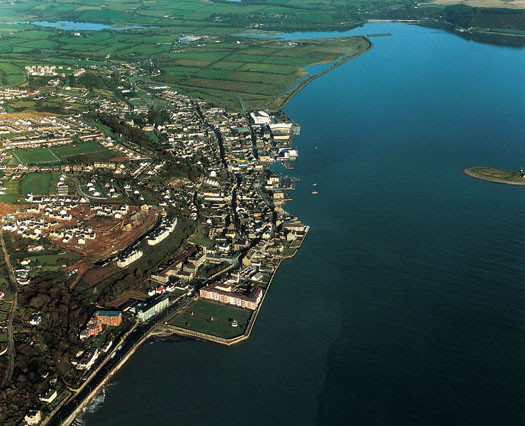
Looking north across Youghal, the aerial view indicates how the crowded waterfront can make it difficult to see the sea. Photo Kevin Dwyer courtesy ICC.
The flotilla will overnight at Villierstown, then they'll take the morning ebb on Sunday to head on downriver, hopefully to reach Youghal at a civilised hour for lunch, while also providing plenty of time for an easy journey home for those who have bought their boats some distance to take part in what could well become a memorable annual event.
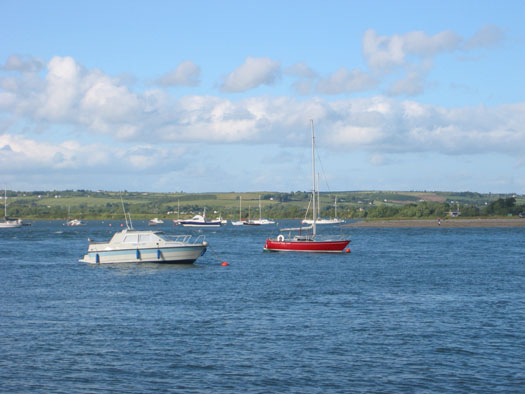
A scattered fleet – boats based in the Blackwater Estuary at Youghal are either on tide-rode moorings off the town (foregound), or in a more sheltered area north of Ferry Point (beyond) on the east side. Photo: W M Nixon
Atlantic Salmon Trust Launches 2012 Auction Online
#ANGLING - The Atlantic Salmon Trust's 2012 Fishing Country Sports Auction went live this week, with some 300 lots offered - including three prime Irish fishing spots on the Blackwater, Mourne and Drowes.
“The annual auction remains our single most significant fundraising event and its success is essential to helping us continue our work,” said AST chief executive Tony Andrews in The Irish Times.
Aside from top fishing opportunities in England, Scotland and Wales, spots in Russia are also featured, as well as deer stalking excursions and shooting days.
For art lovers, sporting prints and watercolours are included in the lots, as is a limited edition of the acclaimed Atlantic Salmon Magic, and Salmon Rivers, one of the best recent publications on the Atlantic salmon. They could be the perfect gift for someone's Valentine's Day.
Bids will close on 14 February for the online auction at www.atlanticsalmontrust.org/auction/.
Ice Diving in Ireland
The recent arctic weather allowed many Irish divers to try out a type of diving that is only normally carried out in the Arctic, Norway, Iceland, Russia, Canada and much more Northern climates writes Timmy Carey. Many Irish rivers froze over completely, something that hasn't happened in recent living memory. This however is a hazardous form of diving as with thick ice if the diver cannot find the hole they entered they will drown if the ice is too thick to break and so they have a rope link to the hole. The other big hazard being hypothermia with the water being a very chilly two degrees celsius!, with most divers being thoroughly chilled after about 10 to 15 minutes. The big advantage
with this type of diving is generally that the visibility is excellent and allows a diver to try out ice diving without the cost of traveling to the arctic circle!
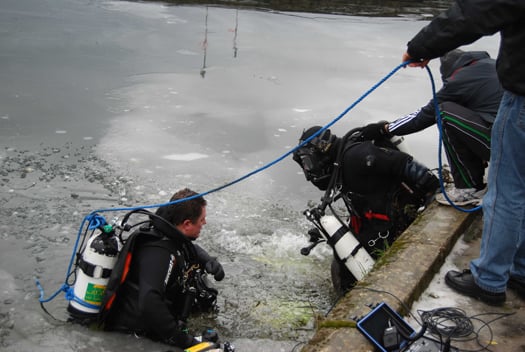

Stephane Portrait surfacing after a 20 minute dive under the ice of the river Blackwater in Munster
River Blackwater Freezes Over
The Munster Blackwater froze over in the middle of Fermoy town preventing anyone from launching boats. Never in living memory on this inland waterway has this occured before writes Timmy Carey.
In 1963 there was some ice on the river during heavy snowfall, but on that occassion the river froze only half way across. A local Fermoy historian Christy Roche thinks that this is the first time that the Blackwater froze right across since 1601, on that occassion it was recorded that Red Hugh O Donnell and Hugh O Neill crossed a frozen river Blackwater on their way to the Battle of Kinsale.
The photo below shows a frozen river Blackwater at Barnane walk in Fermoy, Co. Cork.

Lock and Aqueduct Works Force Canal Closure
In Maynooth, due to the installation of new lock gates and bank repairs at the 14th Lock near Maynooth, the canal will be closed from 17th November 2010 to 31st January 2011, both dates inclusive. It will also be necessary on occasions to close the towpath for health and safety reasons.



























